About Smart Build project
-
Technical solution
-
Project objectives
-
Work performed
-
Results achieved
-
Final results and their potential impact and use
Technical solution
The Information and Communication Technology (ICT) consists of an energy control and management solution composed by different devices and components.
The system has been designed in order to:
- Collect information from the buildings and spaces in real time using sensors, counters and meters (Level 1)
- Send the data to the remote server (Level 2)
- Aggregate and elaborate data for energy analysis and energy efficiency and saving actions scheduling (Level 3)

Environmental benefits
approximately 20-35% energy savings
Expected pay-pack period
4-7 years
Project objectives
Existing public buildings in Italy, Slovenia and Greece were to be retrofitted with a smart ICT concept in order to reach energy savings in annual and peak consumption up to 35% and to provide social-economic benefits to building users, to building managers, to public authorities and to distribution network operators.
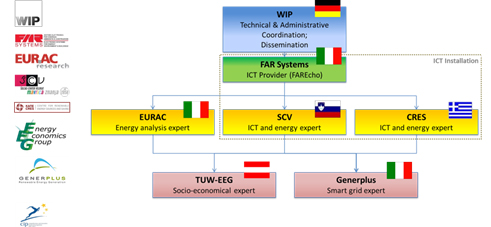
Figure 1. SmartBuild participants and responsibilities.
The ICT concept is based on the off-the-shelf Far Echo “Energy Monitor”, developed by the partner FAR, a subsidiary of the Italian Tosoni Group, for the targeted countries Italy, Slovenia and Greece. The Far Echo “Energy Monitor” was to be implemented in each pilot building according to the building characteristics and national standards.
As an initial step a preliminary analysis of every individual pilot case had been made during the proposal preparation phase in order to have a realistic view of the proposed solutions benefit. A further and more accurate energetic analysis was to be carried out at the beginning of the project and a strategy was to be developed to achieve the foreseen reduction in the energy consumption. The analysis is based on a classification for each pilot of the main loads and energy supply systems, considering their efficiency, timely profile, and the capacity of the current control (if available) to be improved by the installation of the proposed concept based on the Far Echo “Energy Monitor”.
A concluding analysis should compare the energy demand with and without ICT as well as investigate the behaviour/impact of the building occupants and the resulting comfort for the occupants. It should elaborate the benefits of the concept from the technical, economic and societal perspective.
Work performed
Within the initial project phase custom designed pilot ICTs were implemented in nine public buildings with different character, located in three countries. These ICT systems were used for a detailed monitoring of energy streams and comfort parameters and are internally named ICT1 systems. The pilot ICTs are:
- Pilot ICT #1 Instituto Agrario San Michele All‘ Adige, Italy (public office and lab), responsible partner FAR
- Pilot ICT #2 Secondary school “Aldo Stainer” Lavis, Italy (public school), responsible partner FAR
- Pilot ICT #3 Hospital Silandro, Italy (public hospital), responsible partner EURAC
- Pilot ICT #4 School Centre Velenje, Slovenia – public school (Building A: gymnasium), responsible partner School Centre Velenje
- Pilot ICT #5 School Centre Velenje, Slovenia – public school (Building B: higher secondary school), responsible partner School Centre Velenje
- Pilot ICT #6 School Centre Velenje, Slovenia – public school (Building C: higher secondary school), responsible partner School Centre Velenje
- Pilot ICT #7 School Centre Velenje, Slovenia – public sport halls (Building B/C: gyms), responsible partner School Centre Velenje
- Pilot ICT #8 School Centre Velenje, Slovenia – public offices (Building D: offices), responsible partner School Centre Velenje
- Pilot ICT #9 Research centre CRES Pikermi, Greece (public office and lab), responsible partner CRES
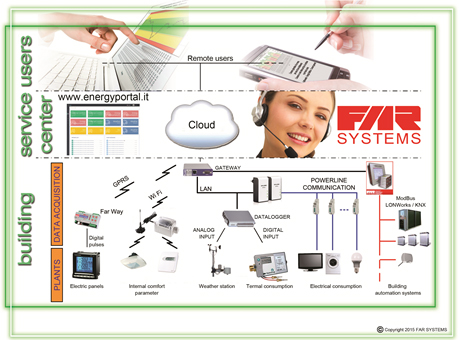
Figure 2. The FAREcho “Energy Portal” and its interface with ICT system components.
This action encompassed the complete and complex process for pilot ICT implementation in several steps: (1) the development of a project specific “energy auditing process”, (2) the development of a suited “energy auditing documentation tool”, (3) the actual on-site building inspection, the “energy audit”, (4) the definition of building/ user specific reference ICT hot-spots, (5) the selection of proper ICT technology, including communication technology, in agreement with the building operator, (6) pre-testing of new ICT components, (7) purchasing of the ICT components, (8) Definition of an ICT parameter code that can clearly be allocated to a specific building, to the location in the building and to the individual ICT component, (9) developing/ adapting the FAREcho “Energy Monitor” software for the ICT system and the data visualisation, (10) pre-setting and programming of the individual components and testing them at real operating conditions before (11) implementing the ICT systems in the individual buildings and connecting it to the web, (12) commissioning the pilots via a standard procedure and (13) operate, maintain and continuously optimise the systems.
ICT implementation was complemented by the development and “on-going feature integration” into the FAREcho “Energy Monitor” of end-user friendly, custom designed, individual monthly reports for every pilot. For the non-specialised building occupant a further feature was integrated: once registered he is enabled to give “real-time” user feed-back about the building comfort and about his satisfaction with the ICT system functions.
Standardised ICT commissioning procedures were developed to assure (1) correct functionality of the installed ICT system, (2) best exploitation of available ICT capacities and, in the following, (3) a correct understanding and evaluation of the collected operational data via the SmartBuild ICT for result assessment. This commissioning procedure was flanked by the creation of a web based tool permitting to regularly conduct surveys among the building occupants with an acceptable effort.
A set of training materials was prepared and adapted to the respective national and pilot context. It was applied in various courses to train occupants and professionals on topics around the SmartBuild ICT system. The set includes questionnaires to occupants on relevant issues allowing for the identification and evaluation of challenges/ benefits related to ICT in buildings.
The implementation of the second series of ICT systems, the control systems, internally named ICT2, basically followed the above procedure described for the first ICT1 implementation phase. Part of this work had a stronger scientific character. Since the project aimed at the demonstration of ICT technologies with replication potential the aim was to include, where possible, cutting-edge technologies promising to cut down investment and O&M costs in future replications.
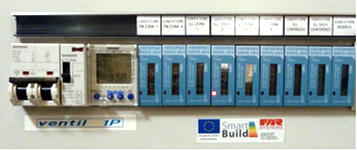
Figure 3. All pilot buildings were comprised with numerous sensors to measure energy streams and comfort parameters within the building. This picture shows electricity meters installed to monitor electricity flows on branch level.
Amongst others, the basis for the continuous ICT1 optimization and for ICT2 implementation was provided by two activities: (1) a review of successful ICT implementations that included a scientific evaluation of pilots realised in Germany and Austria and (2) the development of monitoring procedures, post-processing tools and algorithms to support ICT optimization which were continuously applied and improved. These tools were used to determine the technical, economic and societal benefits of SmartBuild and to draft guidelines for project replication.

Figure 4. ICT data are collected in central electric cabinets on room, zone and/or floor level. The web based FAREcho “energy portal” connects to the central electric cabinet of any building.

Figure 5. Selection of ICT technologies implemented, including for cutting edge wireless electronic thermostatic radiator valves, eTRVs, using energy harvesting technology (picture to the right).
Project activities were accompanied by a series of events to interact with key stakeholders, disseminate project results and foster new collaborations. Activities included the organisation of events and workshops, publications, the installation of SmartBuild energy saving screens at the pilot buildings and the preparation of video material.
Results achieved
With the end of the project all ICT pilots were fully operational in nine public buildings in Italy, Slovenia and Greece. The structured commissioning procedure developed and applied and the results obtained prove that the ICT systems are performing as expected and especially that the key project target to reach energy savings in annual and peak consumption up to 35% and to provide social-economic benefits to building users, to building managers, to public authorities and to distributor network operators was realistic.
SmartBuild found that retrofit ICT implementation in the public buildings investigated is of highest value to increase comfort and to reduce the energy demand of the HVAC systems (Heating, Ventilation and Air Conditioning). On room level measured savings related to the implementation of ICT based monitoring and control HVAC technologies were maximum 55% at an increased level of comfort. On building level savings may cumulate to between 21% and 47% for the pilot buildings, depending on the type of building, the ICT implemented, its occupancy profile and its location. Also, depending on the on-site O&M strategy a significant part of these savings was achieved already via the implementation of the projects’ first phase, the monitoring phase. In general savings resulting from an optimization of existing systems post ICT based monitoring were between 3% and 9%, but there was an exception with 34%.
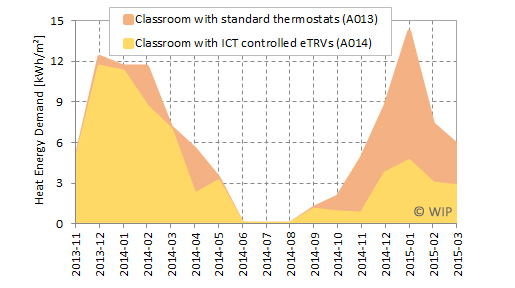
Figure 6. Benefit of ICT2 temperature control in classrooms: comparison in specific heating demand of classrooms between standard room and reference room; Green line: room with ICT2 controlled heating on room level (operational from 02/2014; optimized from 10/2014); Red line: room with manual thermostat based control.
Professional, state-of-the-art and pilot specific “ICT system performance reports” were created which allow for a periodic verification of the function of every individual ICT system and of the efficiency of the respective rooms and buildings. This way the informed building operator can take corrective actions to optimize the comfort in a building and/or to reduce the energy demand without delay.

Figure 7. Exemplary extracts of a typical monthly report.
SmartBuild created a web based tool to conduct surveys about (1) the occupants’ comfort, (2) the occupants’ behaviour and (3) alerts to building managers. This tool will be of high benefit for every future replication because it can help to assess challenges within a building that are known to the occupants but possibly not by the ICT implementing party. Further-on this feed-back is valuable for continuous ICT optimization on hardware level.
Because of changed framework conditions and because of the measured specific Renewable Energy (RE) generation and load profiles at the pilot buildings the work under the topic RE had to be refocused. Nonetheless, the tests and the analysis made allowed to clearly define (1) if and how electric air conditioning systems - heating pump based systems - can be best matched with the production profile of a PV system, (2) to identify factors of relevance for electric power management, specifically in combination with PV production at schools and (3) to develop new cost efficient RE system implementation schemes for a further category of public buildings, social housings, where the financial viability of the RE systems is substantially increased and reached with an ICT based control, such as the FAREcho “energy portal”.
Five larger-scale dissemination actions were organized in in the course of the project in Frankfurt, Paris, Verona, Athens and Velenje. Project results were and are further disseminated via the project web page, via specific publications, via SmartBuild energy saving screens installed at the pilot buildings and via the preparation of a video on the project.
Final results and their potential impact and use
The SmartBuild project implemented the above described system in nine existing public buildings in Europe including schools, administrative buildings, labs and a hospital. The project proved that properly designed and maintained ICT can significantly reduce the annual energy consumption levels in public buildings already today and generate socio-economic benefits.
By 2014 typical SmartBuild pilot building ICT replication costs start at approximately 9 €/m² for the largest building with the largest average building area per ICT controlled room. For smaller buildings and smaller average building areas per ICT controlled room costs may duplicate to approximately 15 to 18 €/m². Best pay-back times are achieved in those buildings that are not yet energetically refurbished (e.g. pilot #2 with around 6 years ICT payback time). But in all pilot cases analysed, already based on the existing framework conditions in terms of energy cost and ICT cost there are reasonable economic trade-offs favouring the implementation of ICT systems.
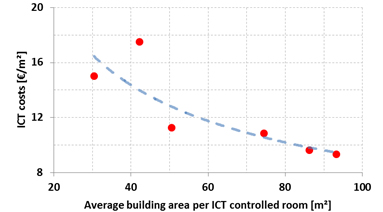
Figure 8. Decrease of average ICT costs for buildings with larger rooms.
In terms of social benefit analyses, the quantification of the avoided external cost in the SmartBuild pilots due to ICT implementation shows impressive positive effects on welfare economics. In a social-welfare economics context the avoided external costs need to be added to the pure economic heating/cooling cost savings as a result of ICT implementation. Doing so, this also implies that from society’s point-of-view the pay-back time of the ICT technologies in the individual SmartBuild pilots is significantly shorter than determined for the pure economic case. In some of the SmartBuild pilots the inclusion of the avoided external cost results in pay-back times of ICT implementation even below 3 years.
The final aim for the industrial partner FAR Systems was to have available a proven, economic and efficient off-the-shelf ICT tool and service for energy monitoring and control in buildings and finally to open-up new markets in the growing sector of “smart buildings”. Thanks to SmartBuild this aim can be achieved in the short-term.
The target users include building owners (public authorities) or tenants, who pay the energy bills, and final users who are exposed to the indoor environmental conditions of the edifice.
Last Update
General update: 07-10-2015 14:11
Information Title Image
For building reference please consider this: http://convention.eurac.edu/Building/geschichte_en.htm
